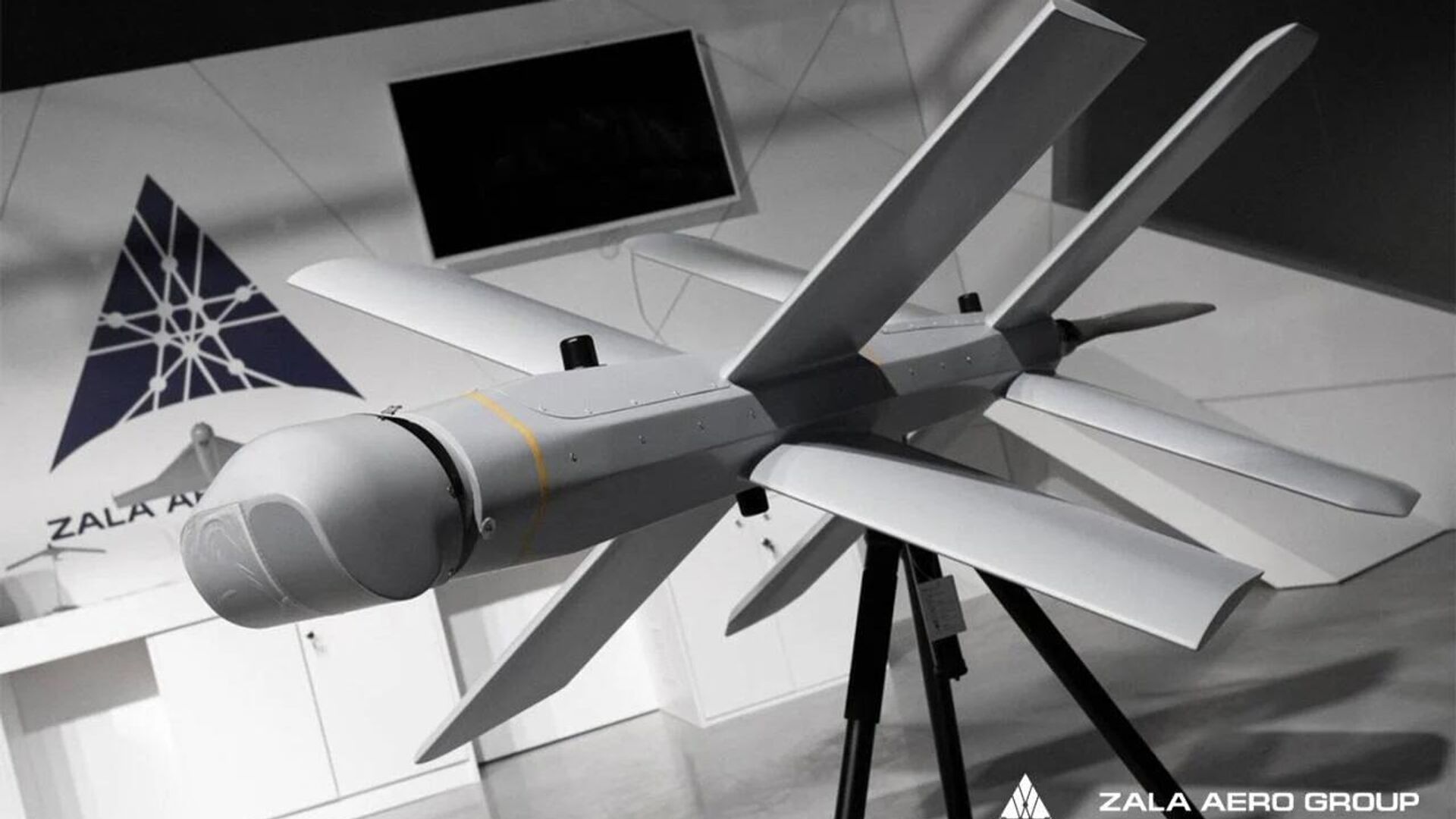https://sputniknews.in/20240220/russia-best-contender-to-provide-india-with-loitering-munitions-6609610.html
Russia Best Contender to Provide India With Loitering Munitions
Russia Best Contender to Provide India With Loitering Munitions
Sputnik India
The Ministry of Defense (MoD) recently approved the procurement of Canister-Launched Anti-Armour Loiter Munition (CALM) systems for the Indian Army through a global tender.
2024-02-20T13:26+0530
2024-02-20T13:26+0530
2024-02-20T13:26+0530
india
russia
us
pentagon
ministry of defence (mod)
military equipment
special military operation
ukraine
moscow
delhi
https://cdn1.img.sputniknews.in/img/07e7/05/0f/1984887_0:74:1280:794_1920x0_80_0_0_f524d499a77ca026aedf197699822242.jpg
The Ministry of Defense (MoD) of India recently approved the procurement of Canister-Launched Anti-Armour Loiter Munition (CALM) systems for the Indian Army through a global tender.The development comes in the backdrop of a study conducted by the London-based International Institute for Strategic Studies (IISS) earlier this month.It found that armed forces worldwide are being influenced by the success of such weapons in Ukraine, especially in the context of loiter munitions, anti-drone systems, and underwater unmanned vehicles.How Does CALM Systems Operate?In essence, A CALM system is a canister packed with loitering ammunition or an Unmanned Aerial Vehicle (UAV).Once fired, it can float in the air for long durations in a warzone, and once a target is located, it can destroy it with the assistance of explosives it is carrying.In this light, Major General (Retd) P.K. Sehgal stressed that there are only five countries in the world that produce the Canister-Launched Anti-Armour Loiter Munition Systems - Russia, China, Iran, the US, and Israel.According to him, at this stage India is laying a huge emphasis on Make in India, Atmanirbhar Bharat (self-reliant India), and full transfer of technology (ToT). While both Russia and Israel are possibly willing to give 100 percent ToT to India, America doesn't seem to be interested in complete ToT.US Not Keen on 100 Percent Transfer of Technology to India"For instance, India is acquiring Predator drones from the US, but the Pentagon is not offering 100 percent technology transfer. Instead, the Americans would set up an MRO (Maintenance, Repair, and Overhaul) facility for these drones in India. In such a scenario, whoever offers the best terms would get this tender because this ammunition is essential for militaries today," Sehgal told Sputnik India on Monday.Nonetheless, if Russia offered the same terms it offered for BrahMos, which is the most successful joint venture between Moscow and New Delhi, it would make it the strongest contender to provide loiter ammunition to India, the retired Indian Army officer opined.Sehgal mentioned that it is worth highlighting that at least 50 percent of India's defense equipment is of Russian origin and if South Block is convinced that Russia would offer transfer of technology and provide all the spare parts etc. during the initial stages irrespective of its involvement in Ukraine conflict, it would be the frontrunner to bag this deal.Russia Could Offer BrahMos Type Deal to Secure ContractOn the other hand, New Delhi is already manufacturing a lot of equipment with the help of Russian assistance to India - T-90 Bhishma tanks, Infantry Combat Vehicles, BrahMos missiles, and a few other systems, including assault rifles.He reckoned that what India would want is not just joint production but also joint-designing, and future upgrades. If there are any upgrades in the weapons platform within India or in Russia, technology should automatically be shared between both countries.Meanwhile, Russian military expert Dmitry Kornev observed that Russia could supply this kind of system to India. He stated that this could materialize through the joint-production route.But he noted that this initiative will take some time before it comes to fruition.Producing These Weapons in India Would Make Them More Legitimate For Foreign Buyers"Even if Russia's Special Military Operation (SMO) concludes tomorrow, Moscow and New Delhi will not be able to start producing these systems in India. But in six months, in a year, they will be able to," Kornev, who is the founder of the Military Russia portal, said in a conversation with Sputnik India.He asserted that India would assemble these systems, and it would make software for them, thereby these loiter munitions would be more legitimate for foreign buyers.In his assessment, they will not be purely Russian, they will be 15, 20, 30, or 40 percent Indian and India will promote the product, of course, as Indo-Russian.Kornev suggested that Russia will need to let India try these devices, that is, carry out various demonstration activities, and put them into trial operation.
https://sputniknews.in/20240219/liberation-of-avdeyevka-represents-strategically-significant-win-for-russia-indian-vet-6605717.html
india
russia
us
ukraine
moscow
delhi
new delhi
Sputnik India
feedback.hindi@sputniknews.com
+74956456601
MIA „Rossiya Segodnya“
2024
Pawan Atri
https://cdn1.img.sputniknews.in/img/07e6/0c/13/139630_147:0:831:684_100x100_80_0_0_8fa2b25903e7787fe6a2698552c167df.png
Pawan Atri
https://cdn1.img.sputniknews.in/img/07e6/0c/13/139630_147:0:831:684_100x100_80_0_0_8fa2b25903e7787fe6a2698552c167df.png
News
en_IN
Sputnik India
feedback.hindi@sputniknews.com
+74956456601
MIA „Rossiya Segodnya“
Sputnik India
feedback.hindi@sputniknews.com
+74956456601
MIA „Rossiya Segodnya“
Pawan Atri
https://cdn1.img.sputniknews.in/img/07e6/0c/13/139630_147:0:831:684_100x100_80_0_0_8fa2b25903e7787fe6a2698552c167df.png
canister-launched anti-armour loiter munition, canister-launched anti-armour loiter munition systems, canister-launched anti-armour loiter munition indian army, canister-launched anti-armour loiter munition indian ministry of defense, canister-launched anti-armour loiter munition indian ministry of defence, canister-launched anti-armour loiter munition india russia collaboration, canister-launched anti-armour loiter munition india russia joint venture, canister-launched anti-armour loiter munition india russia cooperation, india russia relations, indian army news, india russia defense cooperation, india russia defence cooperation, india russia ties, clam systems, loiter munition indian army, loiter munition indian armed forces,
canister-launched anti-armour loiter munition, canister-launched anti-armour loiter munition systems, canister-launched anti-armour loiter munition indian army, canister-launched anti-armour loiter munition indian ministry of defense, canister-launched anti-armour loiter munition indian ministry of defence, canister-launched anti-armour loiter munition india russia collaboration, canister-launched anti-armour loiter munition india russia joint venture, canister-launched anti-armour loiter munition india russia cooperation, india russia relations, indian army news, india russia defense cooperation, india russia defence cooperation, india russia ties, clam systems, loiter munition indian army, loiter munition indian armed forces,
Russia Best Contender to Provide India With Loitering Munitions
Russia has been India's most reliable defense equipment supplier - from warships to missiles to fighter jets to air defense systems to tanks - the Eurasian nation's footprint is visible across the vast terrain in the South Asian country's armed forces.
The Ministry of Defense (MoD) of India recently approved the procurement of Canister-Launched Anti-Armour Loiter Munition (CALM) systems for the Indian Army through a global tender.
"In order to enhance the operational efficiency and domination in the Tactical Battle Area for engaging targets that are Beyond Visual Line of Sight by the Mechanised Forces, the AoN under Buy (Indian-IDDM) category has been accorded for procurement of Canister Launched Anti-Armour Loiter Munition System," the MoD said in a release during the weekend.
The development comes in the backdrop of a study conducted by the London-based International Institute for Strategic Studies (IISS) earlier this month.
It found that armed forces worldwide are being influenced by the success of such weapons in Ukraine, especially in the context of loiter munitions, anti-drone systems, and underwater unmanned vehicles.
How Does CALM Systems Operate?
In essence, A CALM system is a canister packed with loitering ammunition or an Unmanned Aerial Vehicle (UAV).
Once fired, it can float in the air for long durations in a warzone, and
once a target is located, it can destroy it with the assistance of explosives it is carrying.
In this light, Major General (Retd) P.K. Sehgal stressed that there are only five countries in the world that produce the Canister-Launched Anti-Armour Loiter Munition Systems - Russia, China, Iran, the US, and Israel.
According to him, at this stage India is laying a huge emphasis on Make in India, Atmanirbhar Bharat (self-reliant India), and full transfer of technology (ToT). While both Russia and Israel are possibly willing to give 100 percent ToT to India, America doesn't seem to be interested in complete ToT.
US Not Keen on 100 Percent Transfer of Technology to India
"For instance, India is acquiring Predator drones from the US, but the Pentagon is not offering 100 percent technology transfer. Instead, the Americans would set up an MRO (Maintenance, Repair, and Overhaul) facility for these drones in India. In such a scenario, whoever offers the best terms would get this tender because this ammunition is essential for militaries today," Sehgal told Sputnik India on Monday.
Nonetheless, if Russia offered the same terms it offered for BrahMos, which is the most successful joint venture between Moscow and New Delhi, it would make it the strongest contender to provide loiter ammunition to India, the retired Indian Army officer opined.
Sehgal mentioned that it is worth highlighting that at least 50 percent of India's defense equipment is of Russian origin and if South Block is convinced that Russia would offer transfer of technology and provide all the spare parts etc. during the initial stages irrespective of its involvement in Ukraine conflict, it would
be the frontrunner to bag this deal.
"One must not forget that both Israel and the US would try to undercut Russia and hence Russian terms have to be better than that of the Americans or the Israelis," he warned.
Russia Could Offer BrahMos Type Deal to Secure Contract
On the other hand, New Delhi is already manufacturing a lot of equipment with the help of Russian assistance to India - T-90 Bhishma tanks, Infantry Combat Vehicles, BrahMos missiles, and a few other systems, including assault rifles.
He reckoned that what India would want is not just joint production but also joint-designing, and future upgrades. If there are any upgrades in the weapons platform within India or in Russia, technology should automatically be shared between both countries.
"Also, India would want the freedom to sell it to friendly nations. For example, India has already sold the BrahMos to the Philippines and is in advanced discussions to supply it to Vietnam. Besides, Egypt, Indonesia, and a few other countries have evinced their interest in procuring BrahMos from India," Sehgal explained.
Meanwhile, Russian military expert Dmitry Kornev observed that Russia could supply this kind of system to India. He stated that this could materialize through the joint-production route.
But he noted that this initiative will take some time before
it comes to fruition.
Producing These Weapons in India Would Make Them More Legitimate For Foreign Buyers
"Even if Russia's Special Military Operation (SMO) concludes tomorrow, Moscow and New Delhi will not be able to start producing these systems in India. But in six months, in a year, they will be able to," Kornev, who is the founder of the Military Russia portal, said in a conversation with Sputnik India.
He asserted that India would assemble these systems, and it would make software for them, thereby these loiter munitions would be more legitimate for foreign buyers.
In his assessment, they will not be purely Russian, they will be 15, 20, 30, or 40 percent Indian and India will promote the product, of course, as Indo-Russian.
Kornev suggested that Russia will need to let India try these devices, that is, carry out various demonstration activities, and put them
into trial operation.
"But Russia will have to withstand competition with the West and the West will not be delighted with Russia's return to the Indian market. This competition will have to be withstood somehow, perhaps through price, perhaps through dumping, perhaps through technology transfer," he concluded.



